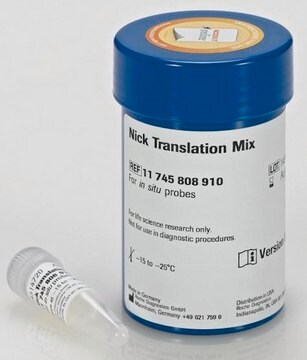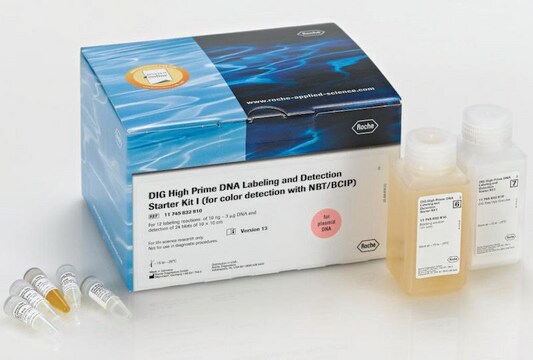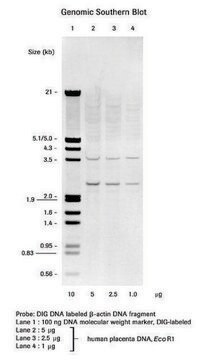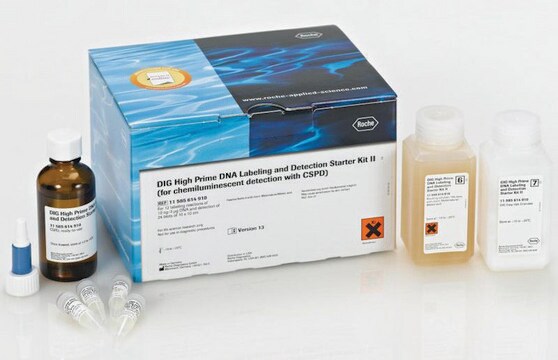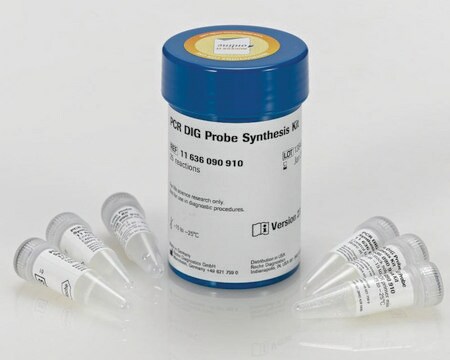11745816910
Roche
DIG-Nick Translation Mix
sufficient for 40 labeling reactions, pkg of 160 μL, suitable for hybridization
Synonyme(s) :
nick translation
About This Item
Produits recommandés
Forme
solution
Niveau de qualité
Utilisation
sufficient for 40 labeling reactions
Conditionnement
pkg of 160 μL
Fabricant/nom de marque
Roche
Caractéristiques du produit alternatif plus écologique
Designing Safer Chemicals
Learn more about the Principles of Green Chemistry.
sustainability
Greener Alternative Product
Technique(s)
hybridization: suitable
Autre catégorie plus écologique
, Aligned
Température de stockage
−20°C
Description générale
Spécificité
Application
Note: The mix can also be used for filter hybridization techniques, however, for highly sensitive filter hybridization probes, we recommend that you use DIG-High Prime from Roche Applied Science.
For nonradioactive labeling of in situ probes with other haptens and fluorophores, Roche Applied Science offers the Biotin-Nick Translation Mix and the Nick Translation Mix (without nucleotides).
Qualité
Principe
E. coli DNA Polymerase I synthesizes DNA complementary to the intact strand in a 5′→3′ direction using the 3′-OH termini of the nick as a primer. The 5′→3′ exonucleolytic activity of DNA polymerase I simultaneously removes nucleotides in the direction of synthesis. The polymerase activity sequentially replaces the removed nucleotides with isotope-labeled or hapten-labeled deoxyribonucleoside triphosphates. At low temperature (+15°C), the unlabeled DNA in the reaction is thus replaced by newly synthesized labeled DNA.
Notes préparatoires
Assay Time: 100 minutes
Sample Materials: Supercoiled and linearized plasmid DNA, Supercoiled and linearized cosmid DNA, Purified PCR products.
Note: Denaturing of the template before nick translation is not required.
Autres remarques
Code de la classe de stockage
12 - Non Combustible Liquids
Classe de danger pour l'eau (WGK)
WGK 1
Point d'éclair (°F)
No data available
Point d'éclair (°C)
No data available
Certificats d'analyse (COA)
Recherchez un Certificats d'analyse (COA) en saisissant le numéro de lot du produit. Les numéros de lot figurent sur l'étiquette du produit après les mots "Lot" ou "Batch".
Déjà en possession de ce produit ?
Retrouvez la documentation relative aux produits que vous avez récemment achetés dans la Bibliothèque de documents.
Les clients ont également consulté
Articles
Digoxigenin (DIG) labeling methods and kits for DNA and RNA DIG probes, random primed DNA labeling, nick translation labeling, 5’ and 3’ oligonucleotide end-labeling.
Notre équipe de scientifiques dispose d'une expérience dans tous les secteurs de la recherche, notamment en sciences de la vie, science des matériaux, synthèse chimique, chromatographie, analyse et dans de nombreux autres domaines..
Contacter notre Service technique
